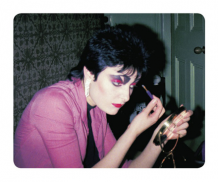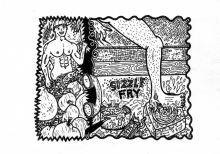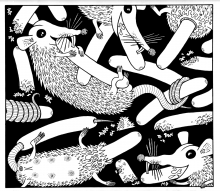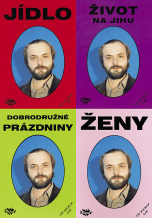| Revista Umělec 2003/2 >> Editorial | Lista de todas las ediciones | ||||||||||||
|
|||||||||||||
EditorialRevista Umělec 2003/201.02.2003 Jiří Ptáček | Editorial | en cs |
|||||||||||||
|
The Czech art scene usually reserves the summer months for preparing the ground for fall shows. Some festivals are considered well in advance, but the harvest usually comes in September. And it appears that this year the launch of the season will not be attended by skepticism and a nagging feeling of absurdity: There is a certain joy and expectation in the air.
Display, the trustworthy darling of the Czech scene, closed for the holiday and put a Vladimír Skrepl installation in the show window, but after September plane tickets were not necessary to see high-quality foreign art. Futura earned its prestigious status thanks to magnanimous promises during the opening of the gallery. After the plastic butts of David Černý, which as a media attraction overshadowed everything in this refined (and somewhat predictable) collective project by Karel Císař, Jiří David came into play as the superhuman producer of (this time) paintings. This shows that Futura will probably avoid taking risks and defend values that have already been established. Are we going to be forced to expect more out of the Třebešice chateau or exhibitions from abroad? Wouldn’t that be a shame? The Tranzit team is working hard and in October they brought to Prague Matthew Barney’s Cremaster 5. A few hundred fans showed up for the one-time projection in Aero cinema. Barney is not well known in the Czech Republic, which is why an aura of speculation, rumor and illusion surrounds his work. This seven-year-old fanciful parable enjoyed its Czech premiere, and, according to reactions that reached my ears, it was surprising but not as colorful as expected. Nevertheless, visual quality, technical perfection and sophisticated conception are, for the Czech conceptual environment, always a good lesson. But other activities swarmed in. They demonstrated that the Czech Republic could soon have an independent network of institutions in which basic cultural anarchy might find a home, and from which the “big concerns” could later draw their strength. In Ustí nad Labem Gallery Raketa has existed for some time, and you can expect an introduction in the next issue. Jana Kalinová recently set up private gallery Kalina in her own flat in the flood zone in Holešovice. Together with Eskort in Brno she now runs two galleries, and our hope here is that she learns to run “Kalina” with more focus than her older, somewhat neglected sister gallery. And let’s also hope that she invests in heating so that the gallery and its curator will survive the oncoming winter. By the way, this same girl had her first solo show in Home Gallery in September. We produced it, so it would be precarious to say that we considered it exceptional. Fortunately, Marek Pokorný offered to review it, so hopefully in this case we haven’t violated the unwritten ethics of Umělec. For this very reason, we avoided reviewing this summer’s festival of the digital image INOUT, also produced by Divus. But thanks to INOUT we got to know Ryutu Amae and Alexandra Györfi, and we liked them so much that we couldn’t help ourselves, so here you will find their profiles. Also worth mentioning is the newborn gallery A.M. 180, which surfaced shortly before the this issue went to print. A group of people in their twenties are behind it, so we’ll wait and see how the youngest generation tries to break the Prague mould. One hint so far: fusion of musical production and art. And then there’s Bedroom Gallery, established practically at foot of the Žižkov tower by a mysterious tattooed women from overseas somewhere who goes by the handle Spy. After a long time there’s a new gallery here with a background from abroad, though tiny and inconspicuous, but different, radical and wild. If everyone can just keep up their enthusiasm, we might just go on living a normal life.
01.02.2003
Artículos recomendados
|
|||||||||||||
|
04.02.2020 10:17
Letošní 50. ročník Art Basel přilákal celkem 93 000 návštěvníků a sběratelů z 80 zemí světa. 290 prémiových galerií představilo umělecká díla od počátku 20. století až po současnost. Hlavní sektor přehlídky, tradičně v prvním patře výstavního prostoru, představil 232 předních galerií z celého světa nabízející umění nejvyšší kvality. Veletrh ukázal vzestupný trend prodeje prostřednictvím galerií jak soukromým sbírkám, tak i institucím. Kromě hlavního veletrhu stály za návštěvu i ty přidružené: Volta, Liste a Photo Basel, k tomu doprovodné programy a výstavy v místních institucích, které kvalitou daleko přesahují hranice města tj. Kunsthalle Basel, Kunstmuseum, Tinguely muzeum nebo Fondation Beyeler.
|






























 New book by I.M.Jirous in English at our online bookshop.
New book by I.M.Jirous in English at our online bookshop.
Comentarios
Actualmente no hay comentariosAgregar nuevo comentario